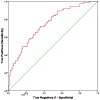Biomarkers in chronic fatigue syndrome: evaluation of natural killer cell function and dipeptidyl peptidase IV/CD26
- PMID: 20520837
- PMCID: PMC2876037
- DOI: 10.1371/journal.pone.0010817
Biomarkers in chronic fatigue syndrome: evaluation of natural killer cell function and dipeptidyl peptidase IV/CD26
Abstract
Background: Chronic Fatigue Syndrome (CFS) studies from our laboratory and others described decreased natural killer cell cytotoxicity (NKCC) and elevated proportion of lymphocytes expressing the activation marker, dipeptidyl peptidase IV (DPPIV) also known as CD26. However, neither these assays nor other laboratory tests are widely accepted for the diagnosis or prognosis of CFS. This study sought to determine if NKCC or DPPIV/CD26 have diagnostic accuracy for CFS.
Methods/results: Subjects included female and male CFS cases and healthy controls. NK cell function was measured with a bioassay, using K562 cells and (51)Cr release. Lymphocyte associated DPPIV/CD26 was assayed by qualitative and quantitative flow cytometry. Serum DPPIV/CD26 was measured by ELISA. Analysis by receiver operating characteristic (ROC) curve assessed biomarker potential. Cytotoxic function of NK cells for 176 CFS subjects was significantly lower than in the 230 controls. According to ROC analysis, NKCC was a good predictor of CFS status. There was no significant difference in NK cell counts between cases and controls. Percent CD2+ lymphocytes (T cells and NK cells) positive for DPPIV/C26 was elevated in CFS cases, but there was a decrease in the number of molecules (rMol) of DPPIV/C26 expressed on T cells and NK cells and a decrease in the soluble form of the enzyme in serum. Analyses by ROC curves indicated that all three measurements of DPPIV/CD26 demonstrated potential as biomarkers for CFS. None of the DPPIV/C26 assays were significantly correlated with NKCC.
Conclusions: By ROC analysis, NKCC and three methods of measuring DPPIV/C26 examined in this study had potential as biomarkers for CFS. Of these, NKCC, %CD2+CD26+ lymphocytes and rMol CD26/CD2+ lymphocyte, required flow cytometry, fresh blood and access to a high complexity laboratory. Soluble DPPIV/C26 in serum is done with a standard ELISA assay, or with other soluble factors in a multiplex type of ELISA. Dipeptidyl peptidase IV on lymphocytes or in serum was not predictive of NKCC suggesting that these should be considered as non-redundant biomarkers. Abnormalities in DPPIV/CD26 and in NK cell function have particular relevance to the possible role of infection in the initiation and/or the persistence of CFS.
Conflict of interest statement
Figures




References
-
- Fukuda K, Straus SE, Hickie I, Sharpe MC, Dobbins, et al. The chronic fatigue syndrome: a comprehensive approach to its definition and study. International Chronic Fatigue Syndrome Study Group. Ann Intern Med. 1994;121:953–9. - PubMed
-
- Reyes M, Nisenbaum R, Hoaglin DC, Unger ER, Emmons C, et al. Prevalence and incidence of chronic fatigue syndrome in Wichita, Kansas. Arch Intern Med. 2003;163:1530–1536. - PubMed
-
- Jason LA, Richman JA, Rademaker AW, Jordan KM, Plioplys AV, et al. A community-based study of chronic fatigue syndrome. Arch Intern Med. 1999;159:2129–2137. - PubMed
-
- Chandler HK, Ciccone D, MacBride RJ, Natelson B. Medically unexplained illness in short- and long-term disability applicants: prevalence and cost of salary reimbursement. Disabil Rehabil. 2008;30(16):1185–1191. - PubMed
Publication types
MeSH terms
Substances
Grants and funding
LinkOut - more resources
Full Text Sources
Other Literature Sources
Medical
Miscellaneous

